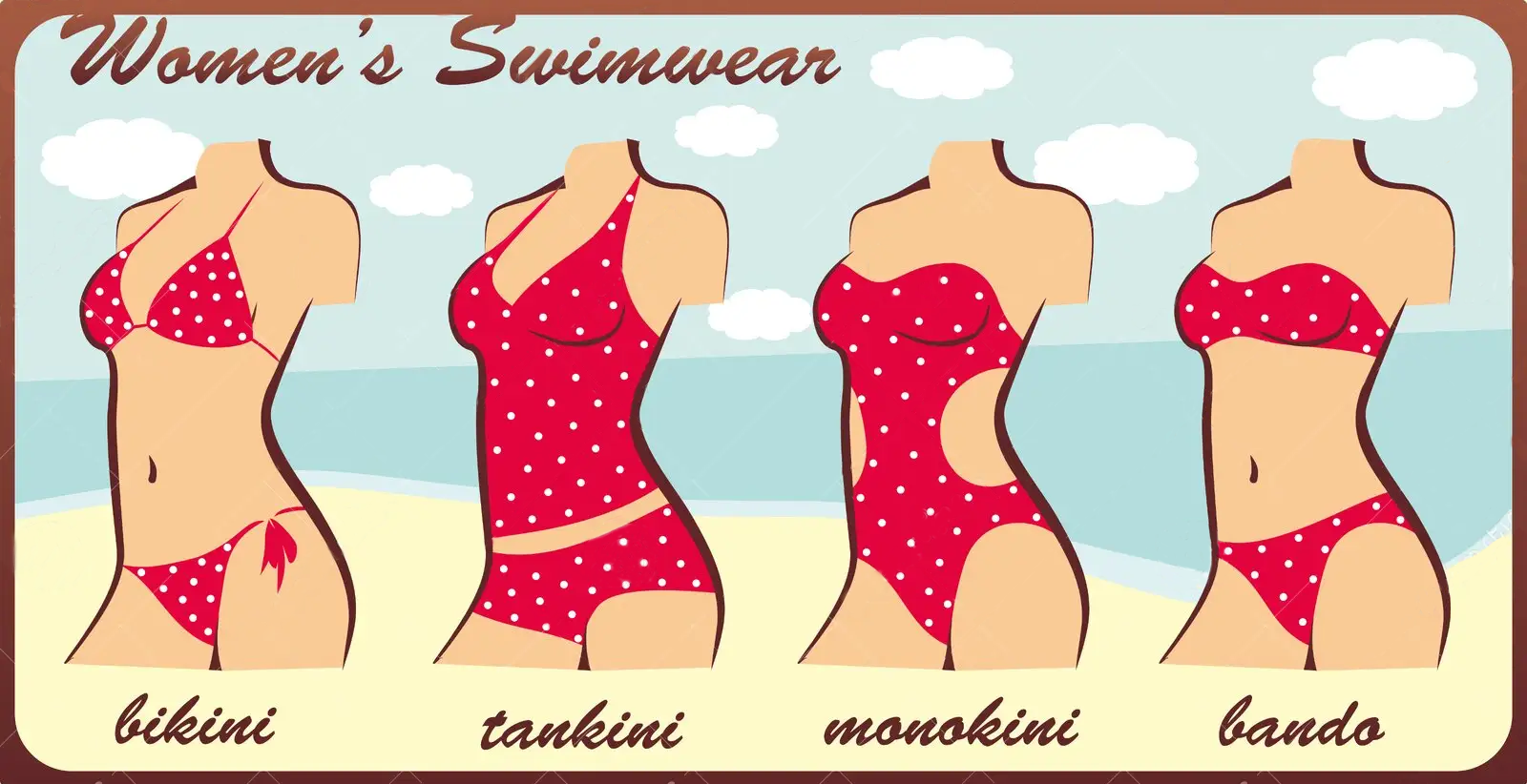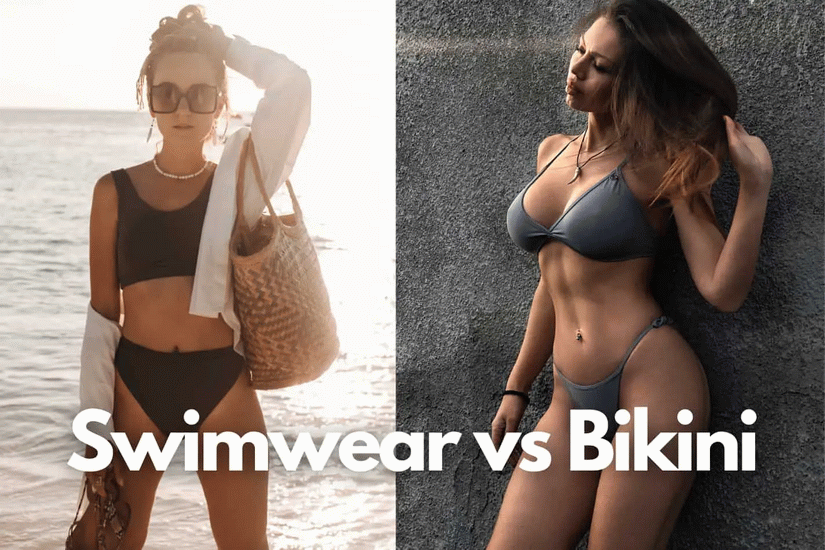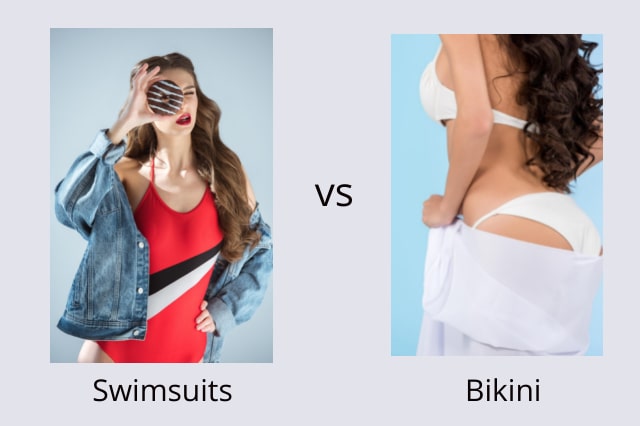Content Menu
What Exactly is a Swimsuit?
What Is A One-piece Swimming Suit?
Swimsuits VS Bikini
> Primary Difference
> Visual Comparison
Pros and Cons of Swimsuits
> Pros of swimsuits
>> Reduce drag
>> Skin Protection
>> More Coverage
>> Less chance of a wardrobe malfunction
>> Packing-friendly
> Cons of swimsuits
>> Coverage
>> More Room for Stains
What Is a Bikini?
Pros and Cons of Bikinis
> Pros of bikinis
>> Cooler
>> Best tan
>> Freedom of movement
> Cons of bikinis
>> Run the Risk of a Wardrobe Malfunction
>> Not Quite so Packing-friendly
Swimsuit Vs Bikini – How To Choose The Right One?
> How much skin do I feel comfortable showing?
> What are the modesty norms of where I'm going?
> Will packing be an issue?
> What will I be using them for?
What's Better? Swimsuit vs Bikini?
When it comes to swimwear, there's one topic of debate that never ceases: "Are swimsuits or bikinis better?" But, of course, when we pose this question, what we're really asking is, "are one-piece or two-piece swimsuits better?"
At Decisive Swimwear, we have loads of opinions about swimwear. So, we've decided to put the swimsuit vs bikini questions to bed once and for all.
While some people use the terms swimsuit vs bikini interchangeably, they're both actually different forms of swimwear. Swimsuits are one-piece designs, while bikinis are two-piece designs. And when it comes to which is better? One-piece swimsuits offer better coverage and security while bikinis tend to win out when it comes to tanning and style.
But it largely depends on the occasion, activity, and personal preference.
So, to discover which takes the top spot, we'll be looking at the pros and cons of bikinis and one-piece swimsuits, starting with measuring up swimsuits.
First of all …
What Exactly is a Swimsuit?
A swimsuit is a clothing item specifically designed for water-based activities. A blend of synthetic materials, including polyester, nylon, and spandex, makes for a comfortably flexible and stretchy yet taut item that's smooth to the touch and ideal for wet environments.
But with that said, swimsuits are also the typical clothing of choice for people partaking in sun-based activities due to their light, breathable fabric and coverage that's just right.
All things considered, this means swimsuits are used for swimming, sunbathing, professional sport, or just a leisurely stroll on the beach. To that end, they come in a variety of shapes, sizes, and styles to suit all preferences and needs.

What Is A One-piece Swimming Suit?
These swimsuits cover your upper, middle, and lower section while leaving your arms and legs bare. Swimsuits can be skin-tight, loose-fitting, and anywhere in between. They are often lined with another layer of fabric to prevent the outer fabric from becoming transparent when wet.
Swimsuits VS Bikini
Primary Difference
The primary difference between a swimsuit and a bikini lies in their design and coverage:
Swimsuit: This term generally refers to a one-piece garment designed for swimming. Swimsuits are often made from materials that are durable and resistant to chlorine and saltwater. They provide full coverage of the torso and are engineered for active use in the water, ensuring they hold their shape and fit during swimming activities.
Bikini: A bikini consists of two separate pieces—a top and a bottom. Bikinis typically cover less skin than swimsuits, exposing the midriff. They come in various styles, including strapless, halter, and more, and are often made with less fabric. Bikinis are popular for sunbathing and casual beachwear, but they may not always be the best choice for active swimming due to their design.
Visual Comparison
Here are some images that illustrate the differences between swimsuits and bikinis:


In summary, while both swimsuits and bikinis serve the purpose of swimwear, they cater to different preferences in terms of coverage and style.
Pros and Cons of Swimsuits
Pros of swimsuits
Reduce drag
One-piece swimsuits tend to be tight-fitting and streamlined. As such, they reduce friction and drag in the water, increasing the speed of a swimmer's forward motion. Unsurprisingly, then, one-piece swimsuits are a favorite among regular and pro-athlete swimmers as they can make swimming that bit easier, alongside an invaluable competitive edge.
Skin Protection
Usually covering the entire torse and a considerable portion of the back, one-piece swimsuits provide excellent protection from harmful UV rays. This also means less sunscreen needed and fewer chances of getting sunburned – a win-win!
More Coverage
As well another benefit of coverage for some swimsuit wearers is comfort. For those who don't want to feel too exposed, one-piece swimsuits offer the perfect medium with plenty of styles to choose from depending on how much skin they feel ready to show.
And, of course, coverage extends itself to peace of mind when it comes to insecurities.
Yet another advantage of covering up is that you can cover up any "imperfections" on your body you deem unacceptable. For example, do you think you're too large or skinny? Do you have scars or a condition you don't want people asking questions about? Or maybe you have a tattoo that you are now embarrassed to show off. No worries, you can simply cover it up with a swimsuit in the meantime.
Less chance of a wardrobe malfunction
One-piece swimsuits are designed to hold tightly to your body. As a result, whether dry or wet, they very rarely slip, much less fall off! This advantageous design makes one-piece swimsuits the best swimwear choice for those who want to participate in water sports such as wakeboarding or jet-skiing.
Packing-friendly
When you opt for a one-piece swimsuit, you have fewer items to fold, pack, and keep track of. When it comes to swimsuits, all you have to do is roll up the suit and place it in your bag.
Cons of swimsuits
Coverage
The one-piece coverage advantage can also be a downside if you're eager to achieve the perfect tan line. Those who are dreaming of even sun-kissed skin may want to give one-piece swimsuits a miss.
More Room for Stains
While most one-piece swimsuits offer excellent protection against the sun's rays, they can also be a nuisance when it comes to sunscreen, sweat, and chlorine stains due to their larger expanse of material.
And there you have it – the advantages and disadvantages of swimsuits.
Now it's time to discover the …
What Is a Bikini?
A bikini is a two-piece form of swimwear. The top part covers the bust area and consists of two triangle-shaped pieces of fabric tied or clasped in the back by strings or clips. Covering the lower half and buttocks are another two pieces of fabric that cover the pelvic area and buttocks, leaving the navel exposed.
Just like one-piece swimsuits, bikinis come in various shapes, sizes, styles, and designs, including Bandeaukinis, Fringe Bikinis, Flounce Bikinis, String Bikinis, and Tankinis.
Pros and Cons of Bikinis
Pros of bikinis
Cooler
You might think we're referring to the popularity of bikinis, which certainly makes them pretty cool. However, what we're really getting at with this point is that bikinis, to their two-piece design, are generally cooler and less heavy to wear on those particularly sunny days, helping you feel fresh and breezy.
Best tan
Bikinis can minimize tan lines thanks to their smaller size and less coverage. Also, since more of your skin is exposed in two-piece swimsuits, the sun is free to bronze more of it – simple as!
Freedom of movement
With no material covering your abdomen and navel, a bikini can rival a swimsuit in terms of comfort. But, while a properly fitting swimsuit should pose no issue, bikini's have the definite edge when it comes to being able to move with ease and without friction – it just feels freer.
Cons of bikinis
Run the Risk of a Wardrobe Malfunction
Even if you don't lose a piece, there is always that fear in the back of your mind that maybe you could lose a piece. Also, even if the two-piece swimsuit stays on your body, the bra could still slip a bit, forcing you to adjust frequently.
Not Quite so Packing-friendly
In the chaos of most holiday suitcases, keeping both pieces of a bikini in one place can be tricky. So, there's always the chance that you'll have to mix and match bathing suit pieces, which is usually not a good look and quite frustrating.
Swimsuit Vs Bikini – How To Choose The Right One?
When it comes to deciding whether a bikini or swimsuit is right for you – it's best to ask yourself a few simple yet effective questions.
How much skin do I feel comfortable showing?
Of course, if you'd prefer to stay covered, a swimsuit is your best option. However, if you have no issue showing off more skin, then a bikini is better for me.
What are the modesty norms of where I'm going?
Suppose you're purchasing a swimsuit to use abroad. In that case, you might want to check the modesty standards of the country you're traveling to in regard to swimwear.
Will packing be an issue?
Would you prefer to keep packing and finding your swimwear easy with a swimsuit? Or are you willing to arrange your bikini pieces.
What will I be using them for?
Will you be partaking in water sports or lounging by the beach? One-piece swimsuits suit more active plans while bikinis are great for laid-back days.
What's Better? Swimsuit vs Bikini?
We're going to take a neutral stance and say that the answer is entirely up to you! On every beach and every pool, you'll see a mix of swimsuits vs bikinis. Some people have a clear favorite, while others' preference changes day-to-day or depending on their plans.
So, take your pick – or don't! Bikinis and one-piece swimsuits are both fantastic in their own ways and meant to be enjoyed equally – so enjoy!




































